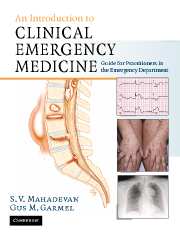Book contents
- Frontmatter
- Contents
- List of contributors
- Foreword
- Acknowledgments
- Dedication
- Section 1 Principles of Emergency Medicine
- Section 2 Primary Complaints
- 9 Abdominal pain
- 10 Abnormal behavior
- 11 Allergic reactions and anaphylactic syndromes
- 12 Altered mental status
- 13 Chest pain
- 14 Constipation
- 15 Crying and irritability
- 16 Diabetes-related emergencies
- 17 Diarrhea
- 18 Dizziness and vertigo
- 19 Ear pain, nosebleed and throat pain (ENT)
- 20 Extremity trauma
- 21 Eye pain, redness and visual loss
- 22 Fever in adults
- 23 Fever in children
- 24 Gastrointestinal bleeding
- 25 Headache
- 26 Hypertensive urgencies and emergencies
- 27 Joint pain
- 28 Low back pain
- 29 Pelvic pain
- 30 Rash
- 31 Scrotal pain
- 32 Seizures
- 33 Shortness of breath in adults
- 34 Shortness of breath in children
- 35 Syncope
- 36 Toxicologic emergencies
- 37 Urinary-related complaints
- 38 Vaginal bleeding
- 39 Vomiting
- 40 Weakness
- Section 3 Unique Issues in Emergency Medicine
- Section 4 Appendices
- Index
37 - Urinary-related complaints
Published online by Cambridge University Press: 27 October 2009
- Frontmatter
- Contents
- List of contributors
- Foreword
- Acknowledgments
- Dedication
- Section 1 Principles of Emergency Medicine
- Section 2 Primary Complaints
- 9 Abdominal pain
- 10 Abnormal behavior
- 11 Allergic reactions and anaphylactic syndromes
- 12 Altered mental status
- 13 Chest pain
- 14 Constipation
- 15 Crying and irritability
- 16 Diabetes-related emergencies
- 17 Diarrhea
- 18 Dizziness and vertigo
- 19 Ear pain, nosebleed and throat pain (ENT)
- 20 Extremity trauma
- 21 Eye pain, redness and visual loss
- 22 Fever in adults
- 23 Fever in children
- 24 Gastrointestinal bleeding
- 25 Headache
- 26 Hypertensive urgencies and emergencies
- 27 Joint pain
- 28 Low back pain
- 29 Pelvic pain
- 30 Rash
- 31 Scrotal pain
- 32 Seizures
- 33 Shortness of breath in adults
- 34 Shortness of breath in children
- 35 Syncope
- 36 Toxicologic emergencies
- 37 Urinary-related complaints
- 38 Vaginal bleeding
- 39 Vomiting
- 40 Weakness
- Section 3 Unique Issues in Emergency Medicine
- Section 4 Appendices
- Index
Summary
Scope of the problem
Urinary-related complaints are found in many patients presenting to the emergency department (ED). The wide variety of complaints can be staggering, overshadowed only by their cost to the health care system. Careful evaluation may uncover undiagnosed congenital abnormalities threatening future renal function, serious infections, or disease complications. Identification of urosepsis allows prompt treatment to prevent subsequent morbidity and mortality.
This chapter focuses on dysuria, hematuria, nephrolithiasis, urinary tract infection (UTI), and acute urinary retention. These categories alone account for billions of health care dollars, and several million ED visits annually. As such, it is important for practitioners to have knowledge of anatomy, evaluation, and treatment.
Anatomic essentials
Urologic anatomy is essentially identical from renal unit to bladder in both sexes (Figure 37.1). It differs from bladder to meatus in obvious ways. The renal unit and the gonads have a similar embryologic origin, so pain in one location is often referred to the other. The kidneys themselves are retroperitoneal organs, relatively protected by the inferior ribs posteriorly.
After formation of urine in the glomerular unit, urine travels into the renal calyces which merge to form the renal pelvis. This renal pelvis cones down to form the ureter. The ureter travels caudally and arises out of the posterior pelvic brim as it crosses over the iliac vessels, then inserts into the bladder itself through a small narrowed intramural portion. It is in these anatomic points of narrowing that calculi of the renal system can potentially lodge.
- Type
- Chapter
- Information
- An Introduction to Clinical Emergency MedicineGuide for Practitioners in the Emergency Department, pp. 543 - 554Publisher: Cambridge University PressPrint publication year: 2005

